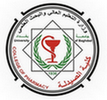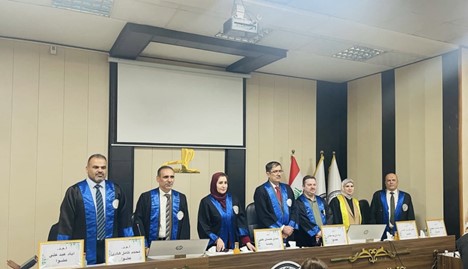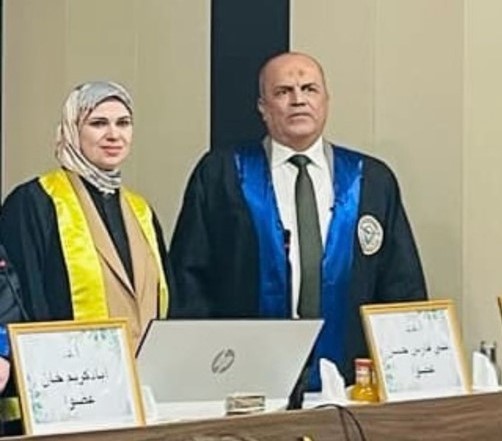The College of Pharmacy discussed the PhD dissertation entitled Design, Synthesis, and Preliminary Cytotoxicity Evaluation of New Benzimidazole Derivatives” by the student Shams Awad Nadhum and the supervisor, Assistant Professor Dr. Mohammed Hassan Mohammed, at the Pharmaceutical Chemistry Department.The study aimed to study the molecular docking and synthesis of a new chain of benzimidazole derivatives as potential inhibitors of alpha estrogen receptors and epidermal growth factor receptors and evaluate the cytotoxicity of the final compounds against selected cancer cells (human lung A529 and breast cancer MCF-7 cells). The study referred to the design and identification of 12 new compounds (1_12)C of benzimidazole derivatives and their characterization and testing them initially as anti-cancer agents. Such new compounds were characterized by spectroscopic techniques: infrared (IR) spectroscopy, proton and carbon nuclear magnetic resonance devices, and mass spectrometry (ESI-MS). Molecular docking was also studied to assess the affinity of the binding of prepared compounds against epidermal growth factor receptors and alpha estrogen receptors. The toxic activity was also evaluated using tetrazolium MTT analysis against two types of human cancer cells. The results showed that some of the prepared compounds have a good toxic effect on cancer cells compared to standard drugs gefitinib and 4-hyroxytamoxifen. Compounds 4C and 6C have an acceptable cytotoxic activity with a half-maximal inhibitory concentration of 73.86 µM and 72.28 µM, respectively, which is comparable to standard gefitinib, which has 75.10 µM against lung cancer cells. Compounds 4C, 6C, 9C, and 12C revealed an acceptable cytotoxic activity with a half-maximal inhibitory concentration (IC50) of 69.68 µM, 71.2 µM, 55.67 µM, and 62.2 µM, respectively, which is comparable to the standard 4-hydroxytamoxifen 70.27 µM against breast cancer cells. The study recommended extending the cytotoxicity study to include lines of other cancer cells and studying molecular dynamics simulation of active compounds. The study also recommended the completion of kinetic studies of 4C, 6C, 9C, and 12C compounds and an in vivo study for the investigation of these compounds in animal’s experiments.



